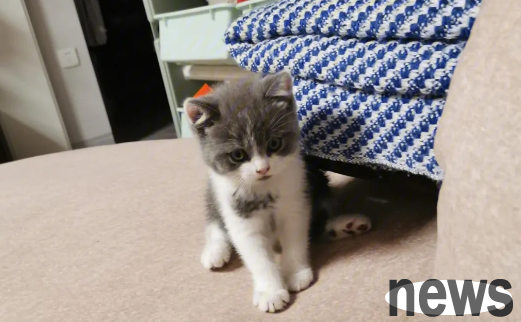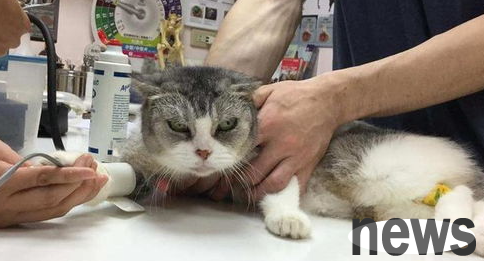For all kinds of diseases in cats, the most terrible thing is not cat plague or cat leukemia virus infection, but infectious peritonitis. Compared with the survival rate of the former, the survival rate of infectious peritonitis is almost 100% comparable to that of rabies (portal:).
Infectious Peritonitis:
Infectious Peritonitis is a chronic progressive infectious disease caused by coronavirus mutations, characterized by peritonitis and accumulation of large amounts of ascites. The virus has weak resistance to the external environment. After leaving the host, it will lose its activity in one day at room temperature. Generally, commonly used disinfectants can kill it. This disease is mainly divided into exudative (wet) and non-exudative (dry), and the course lasts 2-14 weeks (or longer).

animal face pictures Animal pictures Cats, animals, animal faces
1. General symptoms
· Early symptoms are not obvious/not characteristic, weight loss, loss of appetite/intermittent anorexia, weak body condition, depression
· Jaundice
· Anemia
· Different sizes of pupils
· Upper respiratory symptoms
2. Exudate (wet)
· Ascites accumulate, abdominal distension, pain and indentation
· After 7-42 days, there is no pain in the abdomen, and there is fluid
· Body temperature rises to 39.7-41.1℃
· Some cats may experience pleural effusion/pericardial effusion, causing dyspnea (rapid), weak heartbeat, pale mucosa with stagnation (or none)
· Late jaundice
Note: Female cats with exudate types are often mistaken for pregnancy.
3. Non-exudative (dry)
·Long-term fever, loss of appetite,
·Impaired central nervous system (dysfunction, spasm, mild paralysis, etc.)
·Eye infection (initial flaming reticulum bleeding, corneal edema/precipitate, irido-clicular inflammation, redness of the ocular fluid/fibrin clots, etc.)
·Jadeeal
·Abdomen, lumps
·Severe organ failure
4. Risk of infection
Infectious peritonitis can infect cats of all ages, genders, and breeds without distinction. Since almost 40% of the average cat population carry coronavirus, families, cathouses, rescue stations, etc. that raise more than two cats have increased the probability of coronavirus mutation.
Among them, cats under 2 years old and over 11 years old are the main groups of people, especially purebred cats, the incidence rate is higher than that of ordinary cats. The virus is usually transmitted vertically by the digestive tract, parasites, and placenta. Cats can excrete viruses through feces and urine; their characteristics are low morbidity and high mortality.
Note: If you only raise 1-2 cats at home, the chances of suffering from infectious peritonitis are only one in 5,000.
Further diagnosis of hospitals:
Due to the lack of diagnostic basis for infectious peritonitis, the diagnosis will usually be comprehensively confirmed through various laboratory tests.
· X-rays to determine whether there is liquid accumulation in the chest and abdomen
· Detection of extracted liquid
· Chemical evaluation of the function level of kidney, liver and pancreas
· Cardiac test (to exclude heart-related problems)
· Coronavirus test (to determine the presence of antibodies against viruses)
In addition, studies have shown that in exudate symptoms, the fluid in the cat's abdominal cavity is colorless, transparent/light yellow, and coagulation occurs immediately when exposed to air; the peritoneum is cloudy, and like the surface of organs such as liver, spleen and kidney, it is covered with fibrin-like exudates; the liver surface is also necrosis of 1-3 mm, and occasionally sick cats are accompanied by increased pleural effusion.
Treatment method:
is the same as cat plague (portal: survived the "Seven Days of Death" and said goodbye to cat plague). At present, there is no direct radical cure for infectious peritonitis. All it can be done is to help alleviate the pain caused by the disease in cats.
1. Antiviral drug
· GC376, a protease inhibitor antiviral drug
· Virbagen Omega, a recombinant cat interferon omega; after clinical symptoms appear, start treatment as soon as possible, and inject INF omega subcutaneously every 1 MU/kg for observation for a period of time. If there is remission, it can be changed to once a week.
Note: In the drug trial of GC376, the disease was relieved in 7 of 20 cats; Virbagen Omega had cases of successful recovery in young cats during the test.
2. Immunosuppressant
· Prednisolone is the main immunosuppressant of infectious peritonitis. It is safe and can also increase cats' appetite. Take 2-4 mg/kg/day orally, and reduce the dose every 10-14 days until the optimal dose is found for the cat (Prednisolone can also treat lymphocytic cholangitis).
· Thalidomide (not used in pregnant, suppurative peritonitis/pleuritis cats) can reduce inflammation and humoral immune response to cat coronavirus, while keeping the cell-mediated (antiviral) immune response intact; 50-100 mg at night.
Note: In the experiment of prednisolone, a cat with non-osmotic (dry) infectious peritonitis was successfully extended by 10 months; in the experiment of thalidomide, four cats with infectious peritonitis were treated, but all died unfortunately, but a cat with pleural effusion eliminated the pleural effusion and extended the life span by 3 months. Studies have shown that thalidomide needs to be treated early in the disease (before too many blood vessels are damaged).
3. Vitamin
· Vitamin A, 200 i.u./day dose, fed by direct oral administration or mixed with food. Because cats cannot metabolize β-carotene, they can be fed in fish oil such as halibutan liver oil. Considering that taking too much vitamin A will lead to poisoning, so do not consume it for more than 4-6 weeks.
· Vitamin B1, 100μg/day, directly orally or mixed with food.
· Vitamin B complex can promote appetite; use it in children's dosage.
·Vitamin C, take orally orally or consume 125 mg of ascorbic acid twice a day; but taking it for a long time will cause oxalate crystals in the urine.
·Vitamin E, 27-75 i.u./2 times a day, taken directly orally or mixed with food.
4. Other
· Aspirin, used for anti-inflammatory and pain relief; 10mg/kg, once every 48-72 hours.
· Ampicillin, in combination with cats who are using immunosuppressants; 50mg/time.
· Anabolin steroids can promote appetite and anti-catabolic (especially when the kidneys are affected); there are Laurabolin injection (2-5 mg/kg every 21 days), Nandrolin injection (2-5 mg/kg per week), Nandoral tablets (1/day), Proliferative peptide injection (1 mg/kg every 21 days) and Orlando tablets (0.5 mg/kg per day); taking the above drugs, the cat's urine odor will increase.
· Probiotics, which can help cats stop diarrhea
· Thrombin synthase, 5-10mg/kg, twice a day; prednisolone 2mg/kg/day.

During the treatment process, remember to regularly detect various signs of the cat to observe its progress. If there is any relief, the detection time can be appropriately extended. However, the cat still feels pain during the treatment process, and it is recommended to euthanize it. In fact, as long as a cat suffers from infectious peritonitis, it usually can only survive for a few days/weeks; if it is non-exudative, it may survive for a few weeks/months, and then a god-level system problem occurs. At this time, we can only end its pain through euthanasia.
Note: The above governance methods and research evidence are from the personal blog of Addie D.D., PhD, a British veterinary doctor. He has been engaged in the veterinary industry for many years and has rich on-site experience. For the contents of the medication, parents are asked to discuss with the doctor after a comprehensive examination before making a decision.
How to avoid infectious peritonitis in cats:
1. For multiple cat families and cathouses
· Keep one cat and one utensil and do not reuse it. Especially for cat litter box, clean the feces in time every day and disinfect them at least once a week.
· Age grouping. Never let the kittens (less than April) play with the adult cat.
· Isolate cats suspected of being infected to avoid infection.
· After the breastfeeding cat is suspected of being infected, the kittens (4-6 weeks) are weaned and placed separately.
2. Vaccination
Primucell FIP is a live vaccine currently developed for infectious peritonitis. It is provided in the form of an intranasal vaccine and is suitable for kittens under 16 weeks; however, the effect is average. It is recommended to consult a doctor before injection to determine whether the injection is necessary based on the cat's condition.
If there are cats in the home/cathouse that die from infectious peritonitis, 0.2% formaldehyde or 0.5g/L ethyl chloride (chlorhexidine) can be used to disinfect the home, and disinfect the cat's utensils before death and then dispose of them (prevent wild cats from contact); before picking up a new cat, observe whether other cats at home have signs of illness, for at least 6 months.
